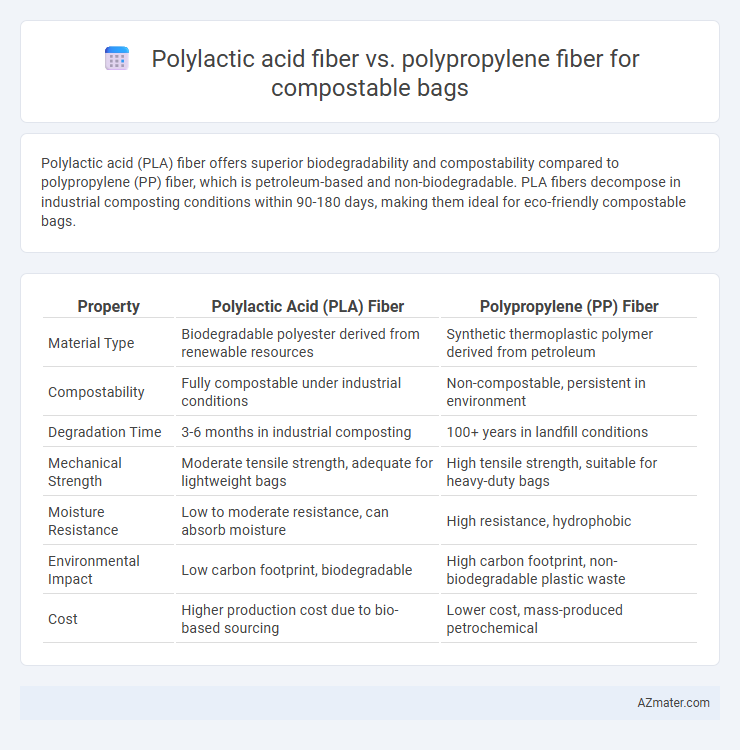Polylactic acid (PLA) fiber offers superior biodegradability and compostability compared to polypropylene (PP) fiber, which is petroleum-based and non-biodegradable. PLA fibers decompose in industrial composting conditions within 90-180 days, making them ideal for eco-friendly compostable bags.
Table of Comparison
| Property | Polylactic Acid (PLA) Fiber | Polypropylene (PP) Fiber |
|---|---|---|
| Material Type | Biodegradable polyester derived from renewable resources | Synthetic thermoplastic polymer derived from petroleum |
| Compostability | Fully compostable under industrial conditions | Non-compostable, persistent in environment |
| Degradation Time | 3-6 months in industrial composting | 100+ years in landfill conditions |
| Mechanical Strength | Moderate tensile strength, adequate for lightweight bags | High tensile strength, suitable for heavy-duty bags |
| Moisture Resistance | Low to moderate resistance, can absorb moisture | High resistance, hydrophobic |
| Environmental Impact | Low carbon footprint, biodegradable | High carbon footprint, non-biodegradable plastic waste |
| Cost | Higher production cost due to bio-based sourcing | Lower cost, mass-produced petrochemical |
Introduction to Compostable Bag Materials
Polylactic acid (PLA) fiber and polypropylene (PP) fiber serve distinct roles in compostable bag production, with PLA fiber derived from renewable resources like corn starch offering superior biodegradability and compostability compared to petroleum-based polypropylene fiber. PLA fibers break down efficiently in commercial composting facilities within 90 to 180 days, aligning with ASTM D6400 and EN 13432 compostability standards, whereas polypropylene fibers exhibit resistance to microbial degradation, prolonging environmental persistence. The material selection impacts sustainability metrics, regulatory compliance, and end-of-life environmental impact, making PLA fiber the preferred choice for eco-friendly compostable bags.
Overview of Polylactic Acid (PLA) Fiber
Polylactic Acid (PLA) fiber, derived from renewable resources like cornstarch or sugarcane, offers excellent biodegradability and compostability, making it a sustainable choice for compostable bags. PLA fibers exhibit good strength, flexibility, and moisture resistance, which are essential for maintaining bag integrity during use and degradation in composting environments. Compared to polypropylene fiber, PLA provides an eco-friendly alternative with its reduced environmental footprint and ability to break down into non-toxic byproducts under industrial composting conditions.
Overview of Polypropylene (PP) Fiber
Polypropylene (PP) fiber is a thermoplastic polymer widely used in compostable bags due to its high tensile strength, chemical resistance, and durability. Its hydrophobic nature makes it resistant to moisture, allowing bags to maintain structural integrity during use. However, unlike polylactic acid (PLA) fiber, PP fiber is not inherently biodegradable, which limits its compostability despite its mechanical advantages.
Environmental Impact Comparison
Polylactic acid (PLA) fiber, derived from renewable resources like corn starch, offers superior biodegradability and compostability compared to polypropylene (PP) fiber, which is petroleum-based and notorious for long degradation periods in landfills. PLA fiber decomposes under industrial composting conditions within 90 to 180 days, significantly reducing greenhouse gas emissions and microplastic pollution associated with PP fiber. However, PP fiber's resistance to degradation contributes to persistent environmental pollution, making PLA fiber a more sustainable choice for eco-friendly compostable bags.
Biodegradability and Compostability
Polylactic acid (PLA) fiber offers superior biodegradability and compostability compared to polypropylene fiber, as PLA decomposes fully into natural byproducts within industrial composting conditions typically in 90-180 days. Polypropylene fiber, a petroleum-based plastic, resists biodegradation and accumulates as persistent microplastics in the environment, failing to meet compostability standards. Therefore, PLA fiber is the preferred material for compostable bags aiming to minimize environmental impact through effective organic waste integration.
Mechanical and Physical Properties
Polylactic acid (PLA) fiber offers high tensile strength and excellent biodegradability, making it ideal for compostable bags that require durability and eco-friendliness. Polypropylene (PP) fiber, while possessing superior mechanical strength and resistance to moisture, lacks inherent compostability and tends to persist in the environment. PLA fibers exhibit lower elongation at break compared to PP fibers, resulting in compostable bags that maintain structural integrity but may be less flexible under stress.
Cost Analysis and Production Scalability
Polylactic acid (PLA) fiber generally incurs higher production costs compared to polypropylene (PP) fiber due to its bio-based raw materials and more complex manufacturing processes. While PLA fiber offers superior compostability, its large-scale production faces challenges related to feedstock availability and process efficiency, limiting scalability compared to the well-established polypropylene fiber industry. Polypropylene fiber benefits from lower cost per kilogram and mature, high-volume production infrastructure, making it more economically viable for mass production but less environmentally favorable for compostable bag applications.
Suitability for Compostable Bag Applications
Polylactic acid (PLA) fiber exhibits superior biodegradability and compostability compared to polypropylene (PP) fiber, making it more suitable for compostable bag applications. PLA fibers break down efficiently under industrial composting conditions, reducing environmental impact and supporting circular economy initiatives. In contrast, polypropylene fibers are petroleum-based, persistent in the environment, and do not readily decompose, limiting their suitability for truly compostable bags.
Market Trends and Consumer Preferences
Polylactic acid (PLA) fiber is gaining significant traction in the compostable bag market due to its bio-based origin and superior biodegradability compared to polypropylene (PP) fiber, which remains popular for its cost-effectiveness and robust mechanical properties. Market trends reveal an increasing consumer preference for PLA bags driven by growing environmental awareness and stringent regulations targeting plastic waste reduction. Despite this shift, polypropylene fibers still dominate in regions prioritizing low-cost solutions, but the global push towards sustainable packaging continues to favor PLA's expansion in eco-conscious segments.
Future Prospects and Innovations
Polylactic acid (PLA) fiber, derived from renewable resources like corn starch, offers superior compostability and biodegradability compared to polypropylene fiber, which is petroleum-based and less environmentally friendly. Innovations in PLA fiber include enhanced mechanical strength and faster degradation rates, making it increasingly viable for high-performance compostable bags. Future prospects for PLA fibers focus on cost reduction through bio-based feedstock advancements and improved recycling technologies, positioning it as a leading sustainable alternative to polypropylene in eco-friendly packaging.

Infographic: Polylactic acid fiber vs Polypropylene fiber for Compostable bag
 azmater.com
azmater.com